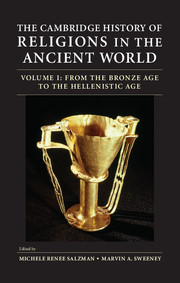Book contents
- Frontmatter
- Contents
- List of Figures and Maps
- List of Contributors
- List of Abbreviations
- Acknowledgments
- Introduction to Volumes I and II
- Introduction to Volume I
- Part I Mesopotamia and the Near East
- Part II Egypt and North Africa
- Part III Greece and the Eastern Mediterranean
- Part IV The Western Mediterranean and Europe
- Suggestions for Further Reading
- General Index
- Index of Citations
- Frontmatter
- Contents
- List of Figures and Maps
- List of Contributors
- List of Abbreviations
- Introduction to Volume II
- Part I Iran and the Near East
- Part II Egypt and North Africa
- Part III Greece and Asia Minor
- 11 Religions of Greece and Asia Minor
- 12 Judaism in Asia Minor
- 13 Christianity in Asia Minor
- Part IV Italy, Roman Gaul, and Spain
- Suggestions for Further Reading
- General Index
- Index of Citations
- References
11 - Religions of Greece and Asia Minor
from Part III - Greece and Asia Minor
Published online by Cambridge University Press: 05 October 2013
- Frontmatter
- Contents
- List of Figures and Maps
- List of Contributors
- List of Abbreviations
- Acknowledgments
- Introduction to Volumes I and II
- Introduction to Volume I
- Part I Mesopotamia and the Near East
- Part II Egypt and North Africa
- Part III Greece and the Eastern Mediterranean
- Part IV The Western Mediterranean and Europe
- Suggestions for Further Reading
- General Index
- Index of Citations
- Frontmatter
- Contents
- List of Figures and Maps
- List of Contributors
- List of Abbreviations
- Introduction to Volume II
- Part I Iran and the Near East
- Part II Egypt and North Africa
- Part III Greece and Asia Minor
- 11 Religions of Greece and Asia Minor
- 12 Judaism in Asia Minor
- 13 Christianity in Asia Minor
- Part IV Italy, Roman Gaul, and Spain
- Suggestions for Further Reading
- General Index
- Index of Citations
- References
Summary
Greek cult practice comprised a broad spectrum of ritual activities that acknowledged and communicated with the multiplicity of deities in the Greek pantheon. Rather than presupposing a body of revealed truth, Greek cult reflected the cumulative expression of the Greeks’ conceptions about the general order of existence and their need to interact with the divine beings that created and controlled that order. Because the Greeks had no authoritative text(s) or central organization that served to codify and interpret their religious system, the best way to approach the topic of Greek religion is to examine the actual rituals and cult observances of the Greeks. Essential rituals included the time-honored practices of prayer and votive offerings to a deity, augmented by animal sacrifice and shared meal on a group level. Cult activities were woven into the lives of virtually all Greeks living in Greece and Asia Minor, and the shared activities of cult practice articulated social networks that strengthened bonds of affiliation with family, community, and state. Such activities could be more elaborate for a larger and wealthier unit, such as a civic festival, while an individual or small group with fewer resources celebrated simpler rites. In the absence of any sacred writings to explain Greek cult practices to us, our principal evidence lies in the physical remains of Greek religion – the sanctuaries, temples, cult images, and votive offerings – and the written texts that discuss these, both literary and epigraphical. Taken together, this material gives us a rich picture of a multifaceted religious experience that was an important component of individual lives.
- Type
- Chapter
- Information
- The Cambridge History of Religions in the Ancient World , pp. 295 - 320Publisher: Cambridge University PressPrint publication year: 2013



